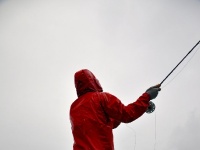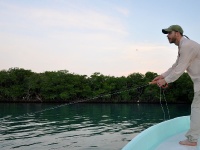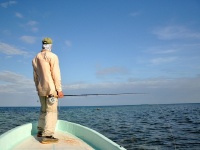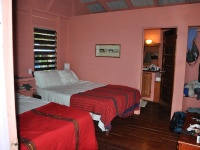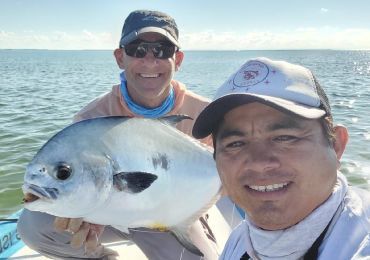When you’re on a mission—you need a game plan.
“So what’s the plan?” my buddy asked.
“Permit, that’s the plan,” I said. I’ve had quite a few opportunities to cast flies at permit in the past but they had always been a species that eluded me. “We have a couple of options.”
“What are the options?” he pressed.
Option No. 1 was Whipray Caye. It’s a small private island about 8 miles off the coast of Placencia, in southern Belize. In my initial review of potential destinations, I tried to balance overall trip costs with reliable fishing programs. I asked around, got a few trusted opinions, and one lodge stood out. “From what it sounds like, it’s a pretty hardcore fishing program,” said. “Tides dictate when and where we fish, nothing is really set. Most likely, we get the whole island to ourselves. The permit fishing is supposed to be off-the-charts.”
“Let’s go with door #1,” said my buddy.
We never really discussed any other options after that.
Two months and four plane rides later… we hopped across the deep green expanse of water just off the coast of mainland Belize and cruised into the smooth calm flats that surround Whipray Caye. As we slowed the boat and motored around the shallow water we could see bait popping on the surface, with larger fish crashing the party. I looked back at one of our guides, Dermin, who was running our shuttle.
“Jacks…. Maybe bonita,” he said. He shrugged his shoulders to note his total disinterest. Dermin was a permit guide—and a damn focused one.
The Mission
The goal of the trip was straightforward. Out of our group of five anglers, only one had ever caught a permit on the fly. And that fish came via dumb luck, chasing bonefish in Ascension Bay. My personal experience with permit consisted of quite a few sightings, multiple presentations, and exactly zero connections.
In addition to targeting permit, we also brought gear that would enable us to chase resident tarpon. Bonefish were also potentially on the docket, but they were low down on the priority list.
The Lodge
Accommodations on Whipray Caye are simple yet extremely functional. When you visit Whipray, it becomes apparent very quickly that the focus is on the fishing program. Two anglers share a room that includes two beds, a shower, and enough room to stow your gear. The main palapa, where we guests converge for meals, offered a lot of room to relax and easy access to cold beers that were always at the ready. We had everything we needed right at our fingertips.
The food at Whipray was a fantastic combination of fresh Belizian seafood and other local favorites—including possibly the best conch fritters on the planet. Over the week we had shrimp, box fish, conch, lobster, rice, beans, and even pork chops. Every morning we were up early and greeted with a breakfast of eggs, bacon, and strong coffee. Lunches consisted of simple sandwiches, fruit, and salty cassava chips.
The Fishing
It’s hard to talk about Whipray Caye without mentioning Julian Cabral, lodge proprietor/accomplished permit guide and fly angler. Cabral might have a reputation as being a little rough around the edges but he wears his dedication for permit fishing on his sleeve. Fishing for permit is not easy and can be frustrating—both for anglers, as well as guides who are trying to get them in front of fish. It’s clear that Cabral and his team are committed to creating as many opportunities for their clients as possible.
That said, the guide staff worked extremely hard and I’ve never clocked as many hours on the water, day after day, as we did at Whipray. Each morning started at 3:45 a.m. Half an hour later, we’d be on the boats, running under the stars. On a few days, we didn’t return to the lodge until after 5 p.m.
From an equipment perspective, we used 9-wt rods capable of throwing weight-forward tropical floating lines for permit. I used a tapered 16-pound fluorocarbon leader and tippet. Fly choice—there are myriad effective crab and shrimp imitations designed specifically for permit—was simple: the Bauer Crab. Our guides liked dime-sized variations in olive or tan. For tarpon I used a 10-wt, with an intermediate sinking line. There are a few places where full, fast-sinking lines are also effective. Leaders included a 60-pound butt section connected to a 30-pound fluorocarbon class tippet, blood-knotted to a 60-pound bite tippet.
On our first day we suffered through a massive rainstorm and passed the time casting for tarpon. But when the weather improved, I fished with Cabral and had more shots at tailing permit in one 90-minute window than my entire permit fishing experiences combined. I blew every single one of them. The conditions were close to perfect—calm with good light—and tailers surrounded us. Sunscreen melted off my face and dripped into my eyes and my shirt was soaked in sweat.
After the fish left the scene, I felt like I had post-traumatic stress syndrome. Cabral was pretty clear about his assessment of the situation. “You gotta relax, man… it’s just a fish,” he said. “You’re still stripping too long and fast. Keep your strips short when they’re tailing. Short strips, like pop, pop, pop.”
In retrospect, this was sage advice. Crabs, unlike shrimp, aren’t designed to swim away in long, aggressive bursts. When predators, such as permit or bones, enter their frame of reference it’s a faceoff. Crabs pause, move in short spurts along the bottom, and pause again. And with that, every opportunity to cast at a permit was also an opportunity to learn something new. Still, after missing six or seven consecutive shots I felt numb. We climbed back into the skiff, Cabral lit another smoke, and we considered our options.
“The tide is going out and it’s not going to be back for a while,” he said. “These fish are heading for deeper water. Let’s go check a new spot.”
Cabral’s assessment was dead on. The one thing to know about Whipray is that you are at the mercy of the tides. When tides push water up onto the flats, the fish move in to dine. When the tide doesn’t cooperate, and are too skinny to offer sufficient cover, finding permit can be a challenge.
In between our better permit tides, we found opportunities to cast toward rolling resident tarpon. Oftentimes this was at first light, when tarpon were actively busting bait on the surface. We had a few hook sets, but never sealed the deal. Our final permit tally, however, was better. During the course of four days, with five anglers, we landed two. While a third was hooked, but broken off.
As I continue fishing for permit, I’m convinced that it’s less about the scorecard and more about the spectacular locales we get to spend time at. Whipray Caye fits the bill, and I’ll be back. The mission is far from over.







